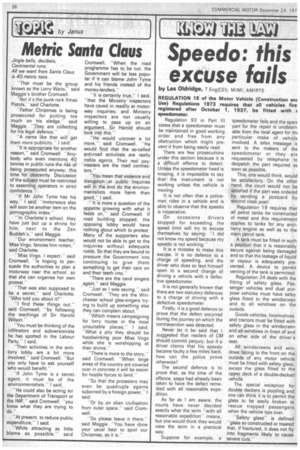Speedo: this excuse fails
Page 38

If you've noticed an error in this article please click here to report it so we can fix it.
by Les Oldridge, T.Eng(CEI), MIMI, AMIRTE REGULATION 18 of the Motor Vehicle (Construction anc Use) Regulations 1973 requires that all vehicles firs. registered after October 1, 1937, be fitted with c speedometer.
Regulation 93 in Part Ill states that a speedometer must be maintained in good working order and free from any obstruction which might prevent it from being easily read. There are few prosecutions under this section because it is a difficult offence to detect. Unless the speedometer head is missing, it is impossible to say that the instrument is not working unless the vehicle is moving.
It is not often that a policeman rides in a vehicle and is able to observe that the speedo is inoperative.
On occasions drivers stopped for exceeding the speed limit will try to excuse themselves by saying: "I did not know my speed because my speedo is not working."
It is a mistake to make this excuse. It is no defence to a charge of speeding, and the driver who does so lays himself open to a second charge of driving a vehicle with a defective speedometer.
It is not generally known that there are two statutory defences to a charge of driving with a defective speedometer.
Firstly, it is a good defence to prove that the defect occurred during the journey on which the contravention was detected.
Never let it be said that I suggested that readers of CM should commit perjury, but if a driver claims that his speedo became faulty a few miles back, how can the police prove otherwise?
The second defence is to prove that, as the time of the offence, steps had already been taken to have the defect remedied with all reasonable expedition.
As far as I am aware, the courts have never decided exactly what the term "with all reasonable expedition" means, but one would think they would view the term in a practical way.
Suppose for example, a speedometer fails and the spar( 'part for the repair is unobtain able from the local agent for thi particular make of vehicIE involved. A telex message it sent to the makers of the speedometer or they are requested by telephone to despatch the part required as soon as possible.
This, one would think, would be satisfactory. On the other hand, the court would not be satisfied if the part was ordered by sending a postcard by second class post!
Regulation 19 requires that all petrol tanks be constructed of metal and this requirement applies to tanks for any anciliarry engine as well as to the main petrol tank.
A tank must be fitted in such a position that it is reasonably secure against being damaged arid so that the leakage of liquid or vapour is adequately prevented. A device to permit venting of the tank is permitted.
Regulation 24 deals with the fitting of safety glass. Passenger vehicles and dual purpose vehicles must have safey glass fitted to the windscreen and to all windows on the outside.
Goods vehicles, locomotives, and tractors must be fitted with safety glass in the windscreen and all windows in front of and on ether side of the driver's seat.
All windscreens and windows facing to the front on the outside of any motor vehicle must be fitted with safety glass, except the glass fitted to the upper deck of a double-decked vehicle.
The special exception for double deckers is puzzling and one can think it is to permit the glass to be easily broken to rescue trapped passengers when the vehicle tips over.
"Safety glass" is defined "glass so constructed or treated that, if fractured, it does not fly into fragments likely to cause severe cuts.'




































































